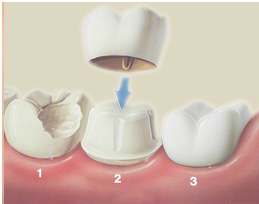Introduction
Dealing with a lost filling or crown can be a distressing experience. Not only can it cause discomfort and sensitivity, but it can also leave you wondering about the best course of action to take. In this blog post, we will discuss everything you need to know about lost fillings or crowns, including the causes, symptoms, and treatment options available. Whether you’re experiencing this issue for the first time or have dealt with it before, this guide will provide you with valuable information to help you make informed decisions about your dental health.
Understanding Dental Fillings and Crowns
When it comes to dental restorations, fillings and crowns play a crucial role in maintaining oral health. Both are commonly used to repair damaged teeth, but they differ in terms of their purpose and application.
Dental Fillings
Dental fillings are used to treat cavities or small areas of tooth decay. They are typically made of materials such as amalgam, composite resin, or porcelain. Fillings are placed directly into the cavity after the decayed portion of the tooth is removed. They restore the tooth’s shape, function, and strength.
Dental Crowns
Dental crowns, on the other hand, are used to cover and protect extensively damaged or weakened teeth. They are often recommended when a tooth has a large filling, a fracture, or has undergone root canal treatment. Crowns are custom-made caps that encase the entire visible portion of the tooth above the gum line, providing strength, protection, and aesthetic improvement.
Causes of Lost Fillings or Crowns
Despite their durability, fillings and crowns can sometimes become dislodged or fall out. Several factors can contribute to this, including:
Decay or Damage
If the tooth surrounding a filling or crown experiences further decay or sustains additional damage, it can weaken the restoration’s bond with the tooth structure, leading to its loss.
Age and Wear
Over time, fillings and crowns may wear down or become loose due to regular use and biting forces. This can result in their eventual loss.
Trauma or Injury
An accident or injury to the mouth can cause a filling or crown to dislodge. The forceful impact can disrupt the bond between the restoration and the tooth.
Summary
Lost fillings or crowns can be a common dental problem that many individuals face. They can occur due to various reasons such as decay, trauma, or simply wear and tear over time. When a filling or crown is lost, it can lead to sensitivity, discomfort, and even difficulty in chewing. Seeking prompt dental care is crucial to prevent further damage and potential complications.
In this blog post, we will explore the causes of lost fillings or crowns, the symptoms to watch out for, and the available treatment options. From temporary home remedies to professional dental interventions, we will discuss the pros and cons of each approach. By understanding the underlying causes and being aware of the available solutions, you can take the necessary steps to address this issue and maintain your oral health.

Whether you’re looking for immediate relief or long-term solutions, this comprehensive guide will equip you with the knowledge needed to navigate through the challenges o see page f a lost filling or crown. Remember, it’s always best to consult with a dental professional for personalized advice and treatment recommendations.
- Q: What should I do if I lose a filling or crown?
- A: If you lose a filling or crown, it is important to see your dentist as soon as possible. In the meantime, you can try to temporarily reattach the crown using over-the-counter dental cement or denture adhesive. Avoid chewing on the affected side and stick to soft foods.
- Q: Can I wait to see a dentist if I lose a filling or crown?
- A: It is not recommended to wait too long to see a dentist if you lose a filling or crown. Leaving the tooth unprotected can lead to further damage or infection. Contact your dentist promptly to schedule an appointment.
- Q: What can happen if I don’t replace a lost filling or crown?
- A: If you don’t replace a lost filling or crown, the affected tooth may become more sensitive, prone to decay, or develop further damage. It is important to address the issue promptly to prevent any complications.
- Q: How can a dentist fix a lost filling or crown?
- A: To fix a lost filling, your dentist will clean the cavity and replace the filling with a new one. If you lose a crown, your dentist will evaluate the tooth and may need to create a new crown to fit properly. The procedure will depend on the specific situation.
- Q: How can I prevent losing a filling or crown?
- A: To prevent losing a filling or crown, it is important to maintain good oral hygiene by brushing and flossing regularly. Avoid chewing on hard or sticky foods that can damage dental restorations. Additionally, visit your dentist for regular check-ups to ensure the integrity of your fillings and crowns.

Welcome to my website! My name is Edward Bramston, and I am a dedicated Dental Anesthesiologist with a passion for providing exceptional care to patients of all ages. With years of experience in the field, I have developed a deep understanding of the importance of dental emergencies, children’s dentistry, and nutrition for oral health.

